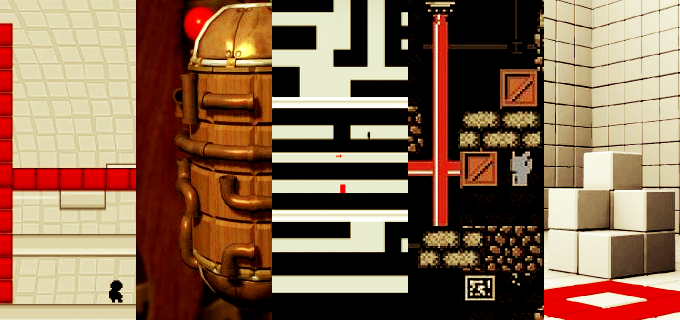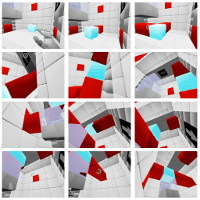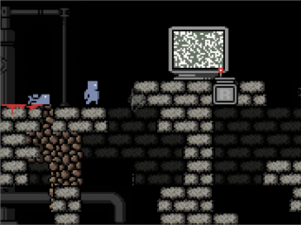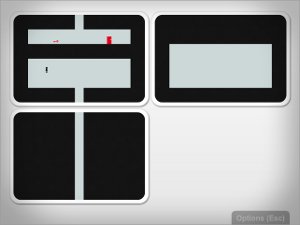 Over the last month or so, Dev.Mag has published five interviews with indie developers discussing puzzle game design. In case you have missed the series, here are links to the articles:
Over the last month or so, Dev.Mag has published five interviews with indie developers discussing puzzle game design. In case you have missed the series, here are links to the articles:
- Introduction
- Rob Jagnow (Cogs)
- Guy Lima (Continuity)
- Ted Lauterbach (suteF)
- Dave Hall (Q.U.B.E)
- Teddy Lee (My First Quantum Translocator)
In this article, I give you my take on the info we gathered in our five puzzle design interviews; a kind of distillation of the various ideas the designers presented. The discussion below is terse with almost no examples; to see how these ideas play out in the design of actual games, you will find the original interviews more helpful.
I chose the games for our series to be what I called “combinatorial puzzles” (an ugly term, a colleague informed me in a friendly email. I agree – if you have a better word, please share!). Puzzle games that make it easy to see how the designer takes core mechanics and put them together into a cohesive, compelling playing experience.
In the introduction article I have said that some principles of puzzle game design apply to all games. Replace “puzzle” with “level” (or other suitable game-playing unit), and the advice offered on selecting mechanics, training the player, handling difficulty and progressions, and playtesting can also be used for more general game design.
What is a good puzzle?
“I feel like when we design something clever,
players enjoy it just as much as we do.” – Teddy Lee
Minimally, a good puzzle:
- has clear rules;
- has a clear objective;
- finds the balance between too easy and frustrating, to make an interesting challenge.
On top of this, an interesting puzzle can be a puzzle that:
- stumps the player for a long time, but whose solution looks obvious once found;
- uses the mechanics in unexpected ways;
- has multiple solutions;
- allows a tiered system so that beginners and novices can play at different difficulty levels.
In puzzle games, puzzles can’t be judged in isolation. Each puzzle should be judged taking into account its role in the sequence of puzzles in the game. For example, a training puzzle will only be good if it occurs in the right place in the game. See difficulty and Progression below for more on this aspect.
Process
“I’ll tweak and tweak until it feels… right.” – Ted Lauterbach
Different designers follow different (although similar) processes to design their games. Here are a few general notes about the design process:
- Design lots of puzzles, and don’t be afraid to throw some away.
- Focus on gameplay, not engine design.
- Designing puzzles before building them (using paper, Excel, or Photoshop) can help to make levels tight and focussed. Designing on paper might not work for all games, in which case prototyping in the engine is a better strategy.
 Design using a prototype. Design using a prototype. |
 Design using Excel. Design using Excel. |
 Design using Photoshop. Design using Photoshop. |
- It’s a good idea to start with the goal, and then insert the elements the player will need to get to the goal, and obstacles that will make it more difficult.
- Consider whether you should add decoys in your game. Decoys can make puzzles more challenging, but can also become unnecessary filler.
- Remove misleading paths (such as the impossible jump that looks possible).
- Test and iterate (see below for notes on playtesting).
- Polish and refine your gameplay.
Mechanics
At the heart of a puzzle game (any game) is the basic rules of the game, the basic actions a player can take.
- Limit the number of mechanics. This lets you focus on:
- level design;
- interesting uses for mechanics;
- polishing mechanics to extract the maximum amount of fun from them.
- Choose flexible mechanics. A handy rule of thumb of Teddy Lee: if you can initially think of five puzzles with a mechanic, chances are you will be able to think up a lot more later on. If you can’t, it probably means the mechanic is too brittle for making many interesting puzzles.
- Use them in the maximum number of ways: explore all their aspects and consequences. You need to know your mechanics inside out.
- Combine mechanics to get emergent gameplay (tricks).
- Reuse mechanics and tricks, but don’t reuse puzzles, otherwise you risk boring the player.
- Stagger themes and techniques to make the overall experience more interesting.
Training the Player
To solve a puzzle, the game must teach the player the rules and the strategies available.
- No one reads, or wants to read, a tutorial.
- Introduce core mechanics in isolation. Teach hard-to-see techniques by making it the only thing the player can do.
- Anticipate misunderstandings and encourage the player to fail and so clear up these misunderstandings early in the game.
 The player is encouraged to jump of the ledge to discover the infinite loop that will require a level restart. The player is encouraged to jump of the ledge to discover the infinite loop that will require a level restart. |
 The only thing the player can do is jump, and then freeze mid-jump while re-arranging the tiles. The only thing the player can do is jump, and then freeze mid-jump while re-arranging the tiles. |
- Control difficulty (see below).
- Ensure the things the player will use to solve the puzzle are easy to see – reduce visual clutter.
- One technique that is especially helpful for illustrating manoeuvres in platform puzzlers is a helper character (perhaps a ghost) to illustrate the actions.
- In cases where dexterity is required, provide visual markers to help the player take precise jumps and other actions.
Difficulty and Progression
The theory of difficulty is straightforward:
- Start with simple puzzles, and make puzzles progressively more difficult and complex.
- Use staggering difficulty or “breather” puzzles to help build confidence and keep the player motivated. After a difficult puzzle, give the player an easy puzzle or two to allow a mental break.
- Let the player know when they are close to the end, especially when the entire playfield is not visible.
 Examples of different difficulty profiles for a sequence of 12 puzzles.
Examples of different difficulty profiles for a sequence of 12 puzzles.
The practice of difficulty design is harder.
- The only sure way to judge the difficulty of a puzzle is to playtest it.
Playtesting
“Sometimes players will not realise something that I thought was quite obvious.” – Dave Hall
“You’d think after failing, people would try a different approach,
but they often don’t.” – Guy Lima
“It’s not because they’re stupid;
it’s because you’ve lost perspective.” – Rob Jagnow
This is possibly the most important step in creating a good puzzle.
- Playtest early and often.
- Playtest with people who have not played the game before.
- Keep quiet, or you won’t find out whether a puzzle is really too difficult:
- don’t offer hints;
- don’t ask questions.
- When player behaviour makes you cringe, it means there is a design problem you need to fix. Here are some ways to fix a problem:
- provide more cues in the level;
- remove distractions that mislead;
- insert more levels before that puzzle to illustrate concepts;
- remove steps from problem to solution;
- cut the puzzle.
- Ask players afterwards about the puzzle and their experience.
- Gather statistics to help measure of difficulty.

What do you say?
If you have additional puzzle game design tips, please share them in the comments!
Thanks for a great series of articles.
Just what I was looking for, thanks!
Great series of articles. There are few game dev websites that I know of doing this kind of work. Kudos to you! I’m finding this quite useful.
Really, really, really THANKS! Exactly what i need, thank you guys devs 😀
Pingback: 7 Games Designed Sites | iX Video Games
Pingback: ????????????????? | GamerBoom.com ???
search whole world finally got here….. keep helping.
🙂
Yeah No kidding at all!
This is where you really can get helps, tips and advises!
Pingback: Gaming: Good or Bad? | My Portfolio
You guys may also take a look at puzzle section of the “Art of Game Design by Jesse Schell” book
Pingback: Preventing players from getting stuck in puzzle games | Gamedev Coder Diary
Love the article! Made me “reply” with a post expanding on the topic of preventing players from getting stuck:
http://gamedevcoder.wordpress.com/2014/05/23/preventing-players-from-getting-stuck-in-puzzle-games/